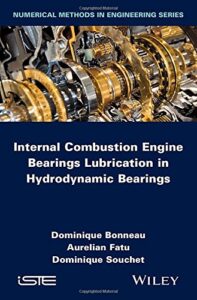Internal Combustion Engine Bearings Lubrication in Hydrodynamic Bearings
Internal Combustion Engine Bearings Lubrication in Hydrodynamic Bearings
Internal Combustion Engine Bearings Lubrication in Hydrodynamic Bearings provides the necessary elements to the development and validation of numerical prediction models for hydrodynamic bearings. This book describes the rheological models and the equations of lubrication. It also presents the numerical approaches used to solve the above equations by finite differences, finite volumes and finite elements methods.
In an internal combustion engine, the combination of mechanical parts, which allows the force exerted by the combustion of gas to be transformed into rotational movement resulting in vehicle wheel rotation, is referred to as “the moving part”. This includes pistons, piston pins, connecting rod bearings, connecting rods and the crank shaft. The small elements related to sealing or assembling the piston and lock rings for piston pin positioning are not discussed. Because of their low mass, these connecting elements barely influence the forces created by the moving part.
You can also Read Grease Lubrication in Rolling Bearings
Internal Combustion Engine Bearings Lubrication in Hydrodynamic Bearings TABLE OF CONTENTS
- Foreword by J.F. Booker ix
![Hydrodynamic Bearings]()
- Foreword by Jean Frêne xiii
- Preface xvii
- Nomenclature xxiii
- Chapter 1 The Lubricant 1
- 1.1 Description of lubricants 1
- 1.2 The viscosity 2
- 1.3 Other lubriciant properties 12
- 1.4 Lubricant classification and notation 14
- 1.5 Bibliography 15
- Chapter 2 Equations of Hydrodynamic Lubrication 17
- 2.1 Hypothesis 17
- 2.2 Equation of generalized viscous thin films 18
- 2.3 Equations of hydrodynamic for journal and thrust bearings 20
- 2.4 Film rupture; second form of Reynolds equation 26
- 2.5 Particular form of the viscous thin film equation in the case of wall slipping 32
- 2.6 Boundary conditions; lubricant supply 35
- 2.7 Flow rate computation 43
- 2.8 Computation of efforts exerted by the pressure field and the shear stress field: journal bearing
- 2.9 Computation of efforts exerted by the pressure field and the shear stress field: thrust bearing
- 2.10 Computation of viscous dissipation energy: journal bearing case 57
- 2.11 Computation of viscous dissipation energy: thrust bearing case 59
- 2.12 Different flow regimes 59
- 2.13 Bibliography 61
- Chapter 3 Numerical Resolution of the Reynolds Equation 673
- 3.1 Definition of the problem to be solved 64
- 3.2 The finite difference method 70
- 3.3 The finite volume method 82
- 3.4 The finite element method 90
- 3.5 Discretization of time derivatives 108
- 3.6 Comparativ analysis of the different methods 114
- 3.7 Accounting of film thickness discontinuities 146
- 3.8 Numerical algorithm for computing bearing axial flow rate 149
- 3.9 Bibliography 155
- Chapter 4 Elastohydrodynamic Lubrication 159
- 4.1 Bearings with elastic structure 160
- 4.2 Elasticity accounting: compliance matrices 163
- 4.3 Accounting of shaft elasticity 178
- 4.4 Particular case of non-conformal meshes 180
- 4.5 Bibliography 184
- Appendix 185
- Index 189
Download


Comments are closed.